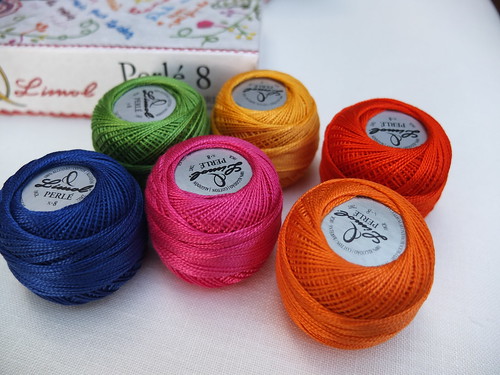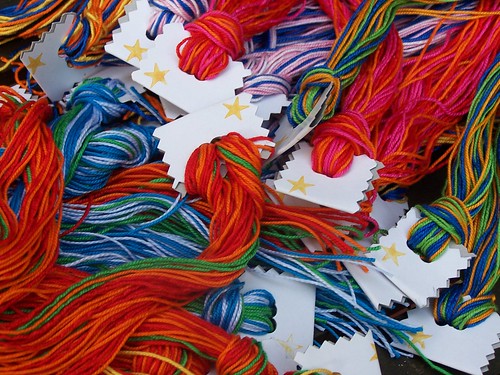I did my best to answer these questions for myself and I decided to share the results I found with you… Portuguese floss manufacturers, Limol, helped me on this, clarifying some doubts and they even captured images of the mercerization process.
 |
| Pearl cotton balls size 8, my photo |
Egyptian Cotton - Extra Long Staple - ELS
The term "Egyptian Cotton" is often used to distinguish high quality cotton fibers, Extra Long Staple cotton - one of the four commercially grown species of cotton. However most products bearing the name are not made with the cottons from Egypt. And even cotton that was grown in Egypt is not necessarily the ELS Egyptian Cotton!!
High quality cotton fibers are very important in the manufacturing process of cotton pearl as only these types of fibers respond well to mercerization (1).
So, often, when trying to describe high quality fibers, manufacturers refer to them as “Egyptian” (2), even when they come from China...
 |
| Skeins used in agulha não pica kits, my own photo |
To produce the best pearl cotton you have to use the best cotton fibers (ELS) and the most demanding manufacturing procedures - combing, gassing and mercerizing (CGM).
When cotton is combed, fine brushes are used to pull out any remaining impurities, along with short cotton fibers. This process removes 15% of the volume and only the long, straight fibers remain, which prevent threads to stick and prickle.
Gassing means passing cotton thread through a flame at high speed to reduce the fuzz. This process also produces a higher sheen.
Mercerization is a treatment that gives yarns a lustrous appearance and softer feel. Technically the mercerization process, devised in 1844 by John Mercer and improved by H. A. Lowe in 1890, consists in treating cotton with strong caustic soda or certain other reagents. After this the treated yarns are washed off.
This refinement results in a permanent change in structure and the fibers become wash-resistant, stronger and thus more stable, meaning that peeling can largely be prevented. This procedure also reduces the natural fuzz along the fiber’s length and increases cotton’s ability to absorb dye.
Here (until 4th step) you'll find a great visual explanation of all the process until mercerization.
See how mercerization works in this video… The cotton threads are rolled into a cylinder. As the cylinder rotates, cotton is immersed in the bath of caustic soda.
Being expensive procedures, combing, gassing and mercerizing are only used for high quality products, like pearl cotton.
And what does it mean to have a pearl cotton size 8?
As you already have noticed, with embroidery thread, the higher the thread size, the finer/thinner the thread. The size of thread has to do with the thread sizing systems. There are fixed weight systems, which measure how much thread weighs a given amount, and fixed length systems which measure how heavy is a given length of thread.
Pearl cotton uses a fixed weight system that is called "thread weight". Within this system, a thinner thread will measure more for a given amount than a thicker thread… And thinner thread will have a higher number than a thicker thread… In very simple words and trying not failing exactness: having a pearl cotton size 8 means that 8 meters of thread weights 1 gram.
Maybe you already knew all this stuff... If so, sorry for boring you... If not, I hope you enjoyed as much as I did learning more about this material that with our hands we use to make our dreams come true...
As I'm not an expert I may have failed to explain all this with accuracy. So, you are invited to contribute with your own knowledge and your thoughts...




Most interesting! Thanks!
ReplyDeleteVery interesting, thank you for sharing!
ReplyDeleteI didn't know most of the facts (especially about perle size :) )
Hugs,
Tatyana
very interesting, thanks for sharing!
ReplyDeleteGreat post! I love learning more about this process. I have a ton of perle cotton but I have no idea if it the super high quality kind.
ReplyDeleteThanks very much for the in-depth reporting. I learned new things!
ReplyDelete